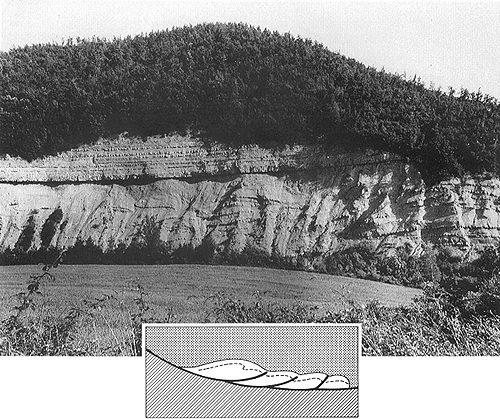
Ancient submarine slide: top unconformity
Plate 131

Ancient submarine slide: top unconformity
Plate 131
A sharply defined angular contact separates two parts of the same formation. The lithology is similar in the two parts (interbedded mudstones and sandstones, with prevailing mudstones), whereas the geometry of bedding is different. Beds are partly broken and folded in the lower part of the section, perfectly continuous and parallel in the upper half.
The original setting was a deep water basin with turbidite events punctuating hemipelagic sedimentation. A thicker turbidite stands out just above the unconformity; it represents a megalayer, i.e., a layer of great volume and basin wide extent, which can be used as a stratigraphic marker (compare with plate 5).
The deformed part of the section has a lateral continuity of some kilometers, and can be interpreted as an Ancient (Miocene) submarine slide, similar to the one of the previous seismic section. One would then expect a wavy surface at its top. The sharp contact means that the surface was smoothed by erosional and depositional events following the slide emplacement (see inset, plate 133.
The slide body is less intensely deformed than the one pictured in plate 129, with bedsets maintaining their parallelism (see right hand side). This suggests to apply the deformation model sketched in the inset, where upslope dipping shear planes subdivide a mass accumulated at the toe of a slope. One of such surfaces cuts diagonally the outcrop (starting from the "V" shaped indentation to the right). If this interpretation is correct, the orientation of the paleoslope can be inferred.
Marnoso-arenacea Formation near Apecchio, northern Apennines.